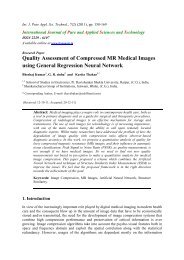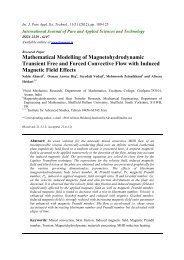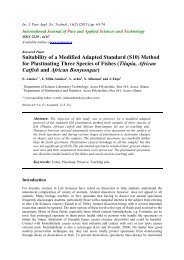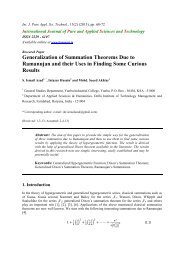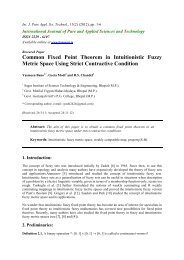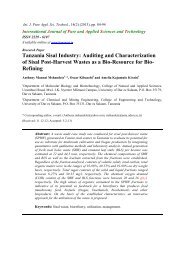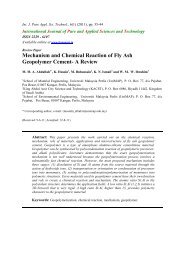Biosorption of Heavy Metals from Aqueous Solution using Bacillus Licheniformis
Biosorption of Heavy Metals from Aqueous Solution using Bacillus ...
Biosorption of Heavy Metals from Aqueous Solution using Bacillus ...
- No tags were found...
You also want an ePaper? Increase the reach of your titles
YUMPU automatically turns print PDFs into web optimized ePapers that Google loves.
Int. J. Pure Appl. Sci. Technol., 10(2) (2012), 12-19. 13<br />
Introduction:<br />
Certain species <strong>of</strong> micro organisms have found to adsorb surprisingly large quantities <strong>of</strong> heavy metals.<br />
Many <strong>of</strong> these metals include those ca<strong>using</strong> toxicity to humans and metals <strong>of</strong> commercial and<br />
economic importance. Removal <strong>of</strong> metals and their recovery is one <strong>of</strong> the major concerns in sewage<br />
and industrial effluent treatment, which is both in municipal and industrial interest. The heavy metals<br />
<strong>of</strong> widespread concern to human health are mercury, cadmium, lead, arsenic, chromium, copper, and<br />
zinc (Lazrova et al., 2005). Nriagu (1988) estimated that over one billion human beings are currently<br />
exposed to elevated concentrations <strong>of</strong> toxic metals and metalloids in the environment and several<br />
million people may be suffering <strong>from</strong> subclinical metal poisoning. Adverse effect <strong>of</strong> heavy metals<br />
include i) suppression <strong>of</strong> the immune system ii) carcinogenicity (Peakall, 1992), iii) neurotoxicity,<br />
mainly in children (Cohen, 2005) iv) inhibition <strong>of</strong> the activity <strong>of</strong> some critical enzymes related to<br />
synthesis <strong>of</strong> vital bio-molecules v) accumulation in the body <strong>of</strong> different organisms ca<strong>using</strong> biomagnification<br />
(Paknikar et al., 2003).<br />
Physico-chemical methods, such as chemical precipitation, oxidation or reduction, electrochemical<br />
treatment, evaporative recovery, filtration, ion exchange and membrane technologies are widely used<br />
to remove heavy metal ions <strong>from</strong> industrial wastewater. However, application <strong>of</strong> these treatment<br />
processes has been found to be sometimes restricted, because <strong>of</strong> investment, operational costs and the<br />
potential generation <strong>of</strong> secondary pollution. These processes may be ineffective or expensive,<br />
especially when the heavy metal ion concentrations in solutions are 1-100 mg L -1 (Volesky, 1990a, b).<br />
It was only in the 1990s that a new scientific area developed that could help to recover heavy metals<br />
<strong>using</strong> biological means i.e. biosorption. The first reports described how abundant biological materials<br />
could be used to remove; at very low cost, even small amounts <strong>of</strong> toxic heavy metals <strong>from</strong> industrial<br />
effluents (Vieira and Volesky 2000). The technique <strong>of</strong> biosorption utilizes the characteristics <strong>of</strong><br />
microoganisms to adsorb metals in a commercial manner. Microorganisms uptake metal, either<br />
actively (bioaccumulation) and/or passively (biosorption) (Fourest and Roux, 1992). This is due to<br />
affinity <strong>of</strong> bacterial surfaces for heavy metals leading to their adsorption and precipitation. The<br />
biosorption is passive non-metabolic process <strong>of</strong> binding various chemicals on biomass (Volesky,<br />
1990a). Most studies <strong>of</strong> biosorption for metal removal deal with the use <strong>of</strong> either laboratory-grown<br />
microorganisms or biomass generated by the pharmacology and food processing industries or<br />
wastewater treatment units (Tsezos and Volesky, 1981; Hussein et al. 2004).<br />
<strong>Bacillus</strong> licheniformis (B.licheniformis) is frequently used in waste water treatment in combination<br />
with <strong>Bacillus</strong> subtilis (Hiatt 2000, Kalia et al. 1994) due to the production <strong>of</strong> extracellular enzymes,<br />
mainly protease and lipase. The extraordinary characters <strong>of</strong> organism which support its application in<br />
sewage treatment are its diverse habitat, ease <strong>of</strong> cultivation, non pathogenic nature to humans, spore<br />
forming ability and its tolerance to environmental stress, starvation etc. There are many reports<br />
describing metal binding sites <strong>of</strong> B. licheniformis. Other than peptidoglycan (basic component <strong>of</strong> cell<br />
wall), B. licheniformis cell wall has high proportion <strong>of</strong> teichoic and teichouronic acid, both <strong>of</strong> which<br />
are responsible for about 60% <strong>of</strong> metal binding (Beveridge, 1982).<br />
These characteristics <strong>of</strong> B.licheniformis prompted us to study efficacy <strong>of</strong> its living biomass in heavy<br />
metal removal. This work mainly deals with biosorption <strong>of</strong> hexavalent chromium ion, cupric ion and<br />
ferric ion by whole cell broth <strong>of</strong> B.licheniformis (NCIM 2471). Effects <strong>of</strong> change in pH and<br />
incubation temperature on metal removal were also studied. Our studies also aimed at determination<br />
<strong>of</strong> heavy metal tolerance <strong>of</strong> the organism <strong>using</strong> the metal ions individually and in combination.<br />
Materials and Methods:<br />
All the chemicals were procured <strong>from</strong> Merck, India and were <strong>of</strong> A.R grade whereas all media<br />
components were <strong>from</strong> Hi Media, India. B. licheniformis (NCIM 2471) was obtained <strong>from</strong> National<br />
Collection <strong>of</strong> Industrial Microorganisms, National Chemical Laboratory, Pune, India. The strain was<br />
maintained by subculturing on nutrient agar. The culture was stored at 4° C between transfers and<br />
subcultured before experimental use.




